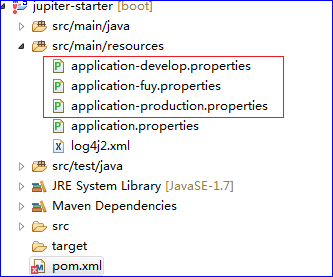Maven的porfile与SpringBoot的profile结合使用详解
使用maven的profile功能,我们可以实现多环境配置文件的动态切换,可参考我的上一篇博客。但随着SpringBoot项目越来越火,越来越多人喜欢用SpringBoot的profile功能。但是用SpringBoot的profile功能时,一般我们默认激活的profile肯定是开发环境的profile。当我们打成jar包后,如果在生产环境下运行,就需要在运行这个jar包的命令后面加个命令行参数来指定切换的profile。虽然这样很方便,但是容易忘记加这个参数。
我们可以通过maven的profile功能和SpringBoot的profile功能结合使用。效果为:当maven打包时通过profile指定配置为test环境的配置,那么我们SpringBoot里面默认激活的就是test环境的配置。 这样我们只需要打包时指定profile后,直接运行jar就可以,不需要在命令行加参数了。这个效果就和我们普通web项目使用maven的profile的效果类似了。
一、思路
(1)通过maven的profile功能,在打包的时候,通过-P指定maven激活某个pofile,这个profile里面配置了一个参数activatedProperties,不同的profile里面的这个参数的值不同
(2)SpringBoot的application.properties文件里面spring.profiles.active填的值取上面maven的activatedProperties参数值。
这样能实现的效果为:
示例一:
maven打包命令为 mvn clean package -P test
那么application.properties里面的spring.profiles.active值就是maven中 id为test的profile的activatedProperties参数值
示例二:
maven打包命令为 mvn clean package -P product
那么application.properties里面的spring.profiles.active值就是maven中 id为product的profile的activatedProperties参数值1
示例一:2
maven打包命令为 mvn clean package -P test 3
那么application.properties里面的spring.profiles.active值就是maven中 id为test的profile的activatedProperties参数值4
示例二:5
maven打包命令为 mvn clean package -P product6
那么application.properties里面的spring.profiles.active值就是maven中 id为product的profile的activatedProperties参数值二、案例
(1)项目结构介绍
项目结构如下图所示,是个常见的SpringBoot项目结构,不同环境的propertis文件的后缀不同(见图中红框处)

(2)pom文件中配置maven的profile
maven的profile的配置见下面代码
注意:maven的profile中activatedProperties参数值需要和SpringBoot的不同环境Properties文件的后缀一样。
比如开发环境的Properties的文件名为application-develop.properties,那么maven中develop的profile里面的activatedProperties参数值就应该是develop
<profiles>
<profile>
<!-- 开发 -->
<id>develop</id>
<activation>
<activeByDefault>true</activeByDefault>
</activation>
<properties>
<activatedProperties>develop</activatedProperties>
</properties>
</profile>
<profile>
<!-- 测试 -->
<id>fuy</id>
<properties>
<activatedProperties>fuy</activatedProperties>
</properties>
</profile>
<profile>
<!-- 生产 -->
<id>production</id>
<properties>
<activatedProperties>production</activatedProperties>
</properties>
</profile>
</profiles>x
1
<profiles>2
<profile>3
<!-- 开发 -->4
<id>develop</id>5
<activation>6
<activeByDefault>true</activeByDefault>7
</activation>8
<properties>9
<activatedProperties>develop</activatedProperties>10
</properties>11
</profile>12
<profile>13
<!-- 测试 -->14
<id>fuy</id>15
<properties>16
<activatedProperties>fuy</activatedProperties>17
</properties>18
</profile>19
<profile>20
<!-- 生产 -->21
<id>production</id>22
<properties>23
<activatedProperties>production</activatedProperties>24
</properties>25
</profile>26
</profiles>(3)application.properties中的配置
在application.properties文件中配置SpringBoot默认激活的propertis文件。这时候spring.profiles.active取上面maven的profile里面配置的activatedProperties的值,这个取值要用@符号来取。具体见下面代码
spring.profiles.active=@activatedProperties@1
spring.profiles.active=(4)如何打包
打包时用 mvn clean package -P profile的id
如果不加-P参数,那么默认就是<activeByDefault>true</activeByDefault>所在的profile
(5)效果图
当我们打包命令为mvn clean package -P production 时,解压后的jar包中application.properties配置文件中spring.profiles.active的值自动变成了production

三、小结
(1)该方式优点:打包后不需要通过命令行参数来切换不同环境的配置文件,把指定环境的这一步放到了maven打包的命令上
(2)该方式其实是利用了maven的profile功能和SpringBoot的profile相结合使用
四、参考链接
作者:zeng1994
出处:http://www.cnblogs.com/zeng1994/
本文版权归作者和博客园共有,欢迎转载!但未经作者同意必须保留此段声明,且在文章页面明显位置给出原文链接!


